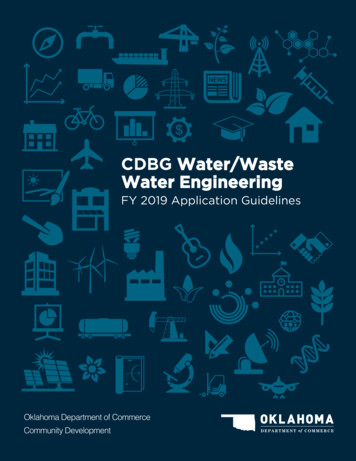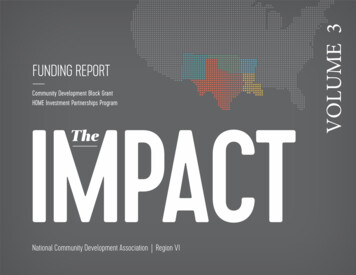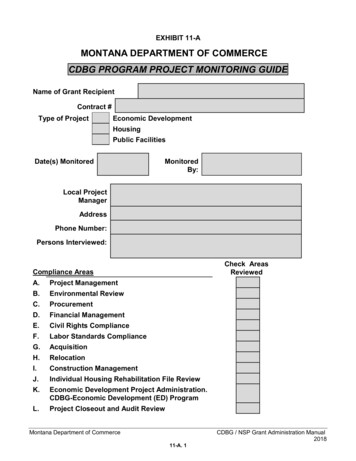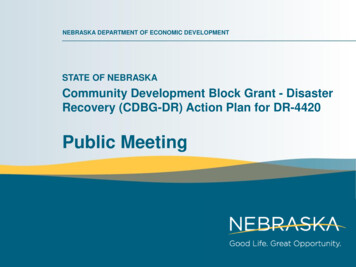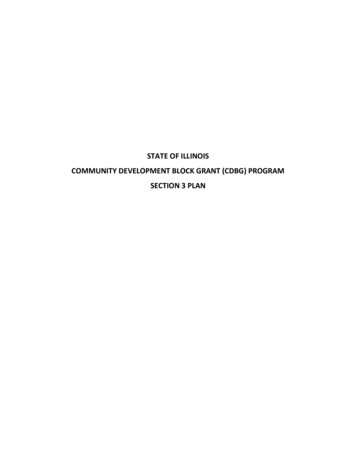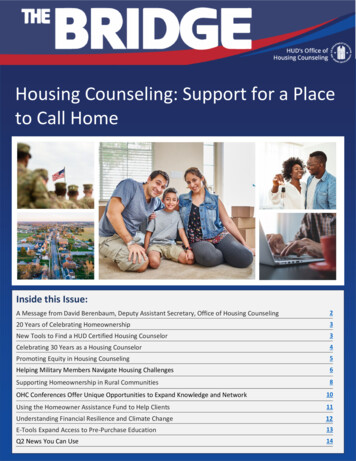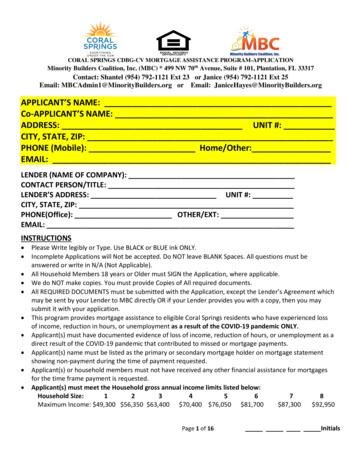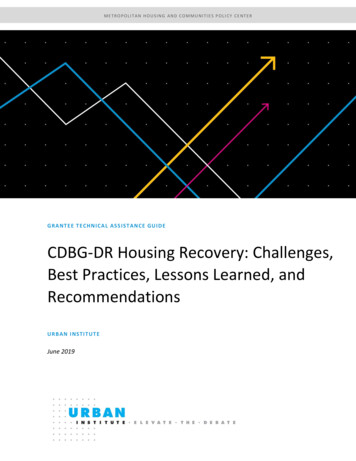
Transcription
METROPOLITAN HOUSING AND COMMUNITIES POLI CY CENTERGR ANT EE TECHNI CAL AS S IS TA N CE GUI D ECDBG-DR Housing Recovery: Challenges,Best Practices, Lessons Learned, andRecommendationsURB AN INSTIT UT EJune 2019
ABO UT T HE U RB AN INST IT UT EThe nonprofit Urban Institute is a leading research organization dedicated to developing evidence-based insights that improvepeople’s lives and strengthen communities. For 50 years, Urban has been the trusted source for rigorous analysis of complexsocial and economic issues; strategic advice to policymakers, philanthropists, and practitioners; and new, promising ideas thatexpand opportunities for all. Our work inspires effective decisions that advance fairness and enhance the well-being of peopleand places.1
CDBG-DR Housing Recovery: Challenges, Best Practices,Lessons Learned, and RecommendationsThis guide presents challenges identified by Community Development Block Grant Disaster Recovery (CDBG-DR) grantees inplanning and implementing their housing recovery programs. The Urban Institute explored these challenges recently in aproject, Improving the Speed of Housing Recovery Program Launch after Severe Disaster, funded by the U.S. Department ofHousing and Urban Development (HUD). As part of the project, the Urban Institute interviewed a purposive sample of CDBG-DRgrantees, technical assistance providers, and HUD staff to identify key areas of focus and concern. The following areas arose ascore challenges that grantees faced when planning and implementing CDBG-DR housing recovery programs: Staff capacity: Developing expertise and capacity to design and implement post-disaster housing recovery efforts,especially in jurisdictions that rarely experience disasters. Hiring enough staff to ramp up quickly for early phases ofprogram planning and implementation and providing ongoing staff training. Grant administration: Determining how to administer CDBG-DR funds and how to manage the recovery programs.Building local capacity among organizations administering housing recovery locally, and ensuring they have asufficient pool of contractors and employers to draw on. Recipient outreach: Communicating with potential program beneficiaries regarding CDBG-DR program expectationsand timeline. Reaching hard-to-serve populations, such as older residents, first-time homebuyers, and residentsuncomfortable interfacing with the government. Case management: Developing case management models to meet the needs of beneficiaries and adequately trainingcase managers. Setting up case management systems that support post-disaster housing recovery efforts. Data management: Drawing on a range of data sources to understand local housing needs after a disaster and informprogram decisions. Developing internal data monitoring systems to collect and track data for long-term housingrecovery programs.Here we discuss each challenge, along with best practices, lessons learned, and recommendations identified through the study.This resource is intended to help grantees prepare for and address these challenges.2
Staff CapacityDeveloping expertise and capacity to design and implement post-disaster housing recoveryefforts, especially in jurisdictions that rarely experience disasters.Common Grantee Challenges Staffing before funding arrives. Hiring sufficient staff to ramp up quickly to develop the action plan and begin earlyphases of program implementation. Attracting staff for short-term positions. Finding qualified staff for short-term positions. Determining when to hire internally or contract out. Deciding which components of the housing recovery program tohandle internally and which to contract out. Handling staff turnover. Dealing with turnover that may arise from burnout associated with long-term recovery orfrom experienced staff leaving to support other disaster recovery efforts or other opportunities within and outsidethe jurisdiction. Lacking post-disaster staff capacity:ooodifficulty determining how many staff members are needed;lack of staff with housing recovery expertise (program management or technical/engineering skills); andshortage of building and housing inspectors and permitting staff.How Can CDBG-DR Grantees Build Staff Capacity?Ensure that the grant’s lead agency has relevant experience. While Nashville-Davidson County did not have prior disasterexperience, its administering agency had implemented housing and infrastructure programs, thus allowing staff to apply thisknowledge and skillset to the CDBG-DR work. The state of Iowa had a similar experience, noting the importance of involvementfrom senior staff with 30 years or more of housing experience. Tapping into staff at other departments who may haveexperience with Community Development Block Grant, Community Services Block Grant, Home Investment PartnershipsProgram, or other relevant knowledge can help staff working on DR get up to speed on the rules and regulations of theprogram.Provide CDBG-DR–specific training for new staff. The Texas General Land Office (GLO) has developed an extensive training planfor onboarding new staff members within six weeks of being hired; permanent staff note the training was especially helpful forbuilding staff capacity and skill. New employees receive a training binder and complete about 30 hours of self-paced training,including CDBG-DR 101, HUD financial management training, a GLO training, Open Records training, and a PBS Frontlinedocumentary series, Business of Disaster.1 The training is intended to give all CDBG-DR grantee employees a commonframework. To provide ongoing coaching and support, GLO also matches new employees with more experienced staff mentors.Draw on contractors to supplement staff and provide technical and policy expertise. This is especially key when ramping-upnew, large scale programs under tight time constraints. Explore contract structures that allow for rapid mobilization.Document best practices and lessons learned. At Texas GLO, key staff documented decisions and procedures in a continuitybinder. This binder serves two purposes: (1) to refer to information in future disasters and (2) to inform the work of future staffafter the current staff leaves. Preparing for future staff is important because staff burnout occurs, and turnover rates can behigh.Retain experienced staff, especially in jurisdictions that frequently experience disasters. For instance, New York City isdeveloping an office of recovery preparedness that would have the expertise needed to plan for and lead housing recoveryefforts, such as CDBG-DR programs, following disasters. The Texas GLO plans to ask its legislature for funding for at least askeletal recovery staff to prepare for disaster recovery before federal funds become available.1See “Business of Disaster,” Frontline, May 24, 2016, f-disaster/.3
Give short-term staff the training and skills needed to transfer to other positions (e.g., policy, planning, and outreach jobsmay lead to compliance and monitoring and communications jobs in the long term). Some larger repeat grantees, such asLouisiana and New York City (NYC), reported training CDBG-DR staff for more permanent positions. The NYC Mayor’s Office ofHousing Recovery Operations (HRO) is working to transition staff into other agencies to keep them employed through citygovernment as they wrap up Hurricane Sandy recovery.Other Suggestions from Grantees and Stakeholders for Building Staff Capacity Identify a lead agency for CDBG-DR funded programs prior to a major disaster, to the greatest extent practical. Clearlydefine how that organization will interact with other governmental departments and with surrounding jurisdictions. Look to recent retirees with disaster recovery experience from other surrounding jurisdictions—those with disasterrecovery experience—who can support program planning, policy development, and training, especially during theearly phases of a program while staffing up. Recent retirees may not necessarily want long-term assignments butcould help with shorter-term planning and implementation tasks. Ask other previous or current CDBG-DR grantees to share their job descriptions, then tailor descriptions to yourprogram accordingly. Recruit from universities (recent graduates, interns, cooperative education students), especially for entry-levelpositions. These students have valuable skills (urban planning, architecture, engineering, information technology,geology, accounting, finance, financial management, communications, etc.), and they have room to advance in thefield. Enlist universities for defined projects, such as data collection (e.g., surveys), data analysis, and literature reviews. Use mutual aid compacts/agreements with other jurisdictions to increase the number of building and housinginspectors and permitting staff. Invest in internal staff. All grantees seemed to agree that investing in internal staff should be the primary strategy.However, hiring consultants, as augmentations or backups to the organization’s staffing plan, can provide extrasupport when staffing is limited.Additional Resources Available on HUD ExchangeCDBG-DR staffing effortanalysis toolTraining and technicalassistance guideStaff CapacityExcel spreadsheet worksheets for planning program staffneeds and identifying staffing gaps, with instructions and anexample.An overview of key training-related tasks to consider over thegrant, to ensure that staff have the skills and knowledge toadminister CDBG-DR grants. Provides guidance ondetermining training needs, developing tailored training, andassessing training GDR-Training.pdf
Grant AdministrationDetermining how to administer CDBG-DR funds and how to manage the recovery programs.Common Grantee Challenges Deciding whether to administer programs directly or distribute funds to local government units. States and urbancounties determining whether to administer programs directly or subgrant to cooperating jurisdictions. Handling lack of local capacity. Building capacity to implement housing recovery through ongoing training andtechnical support. Having a sufficient workforce in the community to carryout program activities. Ensuring that there are enoughqualified local contractors and employers, and creating workforce development programs to address gaps, if needed.How Can CDBG-DR Grantees Approach Grant Administration to Most EffectivelySupport Housing Recovery on the Ground?Consider hybrid state grant administration models in which the grantee runs some statewide programs and localgovernments run other programs. Following Hurricane Harvey, Texas GLO implemented state-run recovery programs in 48counties and made direct allocations to Harris County and Houston. To engage closely at the local level, the state collaboratedwith long-term recovery committees in counties and cities throughout Texas. For instance, recovery committees helpedpublicize a checklist of materials and information that homeowners could start to gather in preparation for the applicationprocess.Create a network of Council of Governments (COGs) to lead grant administration. Because of the number of counties (85)included in the presidential disaster declaration, Iowa used a network of 11 super COGs and 7 entitlement cities to administerCDBG-DR recovery following major flooding.2 Super COGs were selected based on their experience and capacity to implementhousing recovery programs. The super COGs were administrative hubs for working with and overseeing recovery programswithin a particular geographic region.Each super COG encompassed several counties, with the county in which the super COG was located acting as the lead and as asubrecipient of the state. The state helped the super COGs plan, administer, and manage recovery programs through ongoingtechnical assistance. A subrecipient could contract with a COG or other entity to administer the program.Partner with other state and local agencies that have experience administering the types of programs that the grantee isfunding (housing finance authority for multifamily rental housing deals, housing counseling agencies for housing counseling,etc.). According to Louisiana’s Office of Community Development, even if these partnerships are not formalized or designatedas subrecipients to the grantee, it is beneficial to involve other local agencies in planning processes early on—in a clearlydefined role. States such as Minnesota and North Carolina have also developed formal interagency councils to fostercollaboration for CDBG-DR recovery.Help subrecipients understand CDBG-DR grant requirements. Set standards and program requirements early on in the grantperiod, particularly for quality control and oversight of contracting. Help subrecipients understand these standards and generalCDBG-DR regulations. This can mean doing a lot of outreach and “boots on the ground” in-person technical assistance. It is alsohelpful to establish procedures for communicating changes in requirements, such as new rules or new required documentation.Assign a grant manager to each local subgrantee to serve as a single point of contact for the CDBG-DR program and provideongoing technical assistance. For example, Texas GLO has shifted to a portfolio management system, in which grant managersare assigned at the state level to each of the local subgrantees. Grant managers help walk subgrantees through the recoveryprocess, providing tailored technical assistance for staff. This involves mini trainings over the grant life cycle, on such topics as2See State of Iowa Community Development Block Grant Disaster Recovery Policies and Procedures Manual, State of IowaEconomic Development, rograms/CDBG-DR-Manual2017.pdf. Usesearch term “COG.”5
procurement, CDBG-DR national objectives, needs assessments, application and submissions requirements, and grantcloseouts.Develop a toolkit for subrecipient jurisdictions to help facilitate their learning and smooth program startup, especially thosenew to operating CDBG-DR. For instance, Texas GLO developed a guidebook to support subrecipient jurisdictions’ grantplanning, implementation, and management. This resource covered such topics as outreach procedures, procurement, andconstruction oversight—informed by lessons from past disaster recovery efforts. The guidebook can complement any ongoing,tailored assistance grantees receive.Know the workforce’s limitations to carry out housing recovery program activities in the affected community, and addressthese limitations. As part of its Build It Back program, New York City launched a workforce program, which included:3 job matching and recruitment events with Build It Back contractors and other local employers, with impactedresidents receiving priority access; job-training vouchers for union pre-apprenticeship programs, which provided the opportunity for direct entry toconstruction union apprenticeships; and career counseling, résumé editing, and practice interviews.Other Suggestions from Grantees and Stakeholders for Approaching GrantAdministration Consider how you might cover operational expenses before HUD approves the CDBG-DR action plan. For instance,Texas GLO noted borrowing from general revenue funds to support these expenses. Keep in mind that granteescannot use existing DR funds. Conduct an inventory of state and local agency capacity to identify areas of strength and limited capacity amongagencies that can support CDBG-DR housing recovery efforts. Learn about program design, policies, and pitfalls through peer-to-peer engagement, trade associations, andacademic studies. Identify high-risk areas that may be impacted by disasters. Engage in comprehensive pre-planning to determine howthey might use funding for housing recovery after a disaster. Planning should also include information about who isgoing to do what (e.g., agency to agency, locality to locality), and potential data sources to draw on. Specific recommendations identified by the NYC Mayor’s Office of Housing Recovery Operations in its recentlyreleased report Patterns of Attrition and Retention in the Build It Back Program included the following:4ooooGroup housing recovery program applicants by current housing situation so displaced residents (owners orrenters) and at-risk homeowners can be prioritized more easily. Track displaced applicants to know whetherthey have reoccupied their homes after repairs or are still displaced, and assess the condition of the home,if reoccupied, because some may return to homes that are unsafe.Communicate clearly about the application process and deadlines for completing applications. Assign a casemanager when needed who can help with document submission, contractor selection, and finding otheravailable resources during the application process.Collaborate with nonprofit service providers during disaster assistance planning, especially nonprofit legaland financial counseling services.Develop communications and outreach strategies to follow throughout the life of the program, manageexpectations, and provide understandable and regularly updated information.3“Workforce,” NYC Housing Recovery, New York City’s Mayor’s Office of Housing Recovery ry/programs/workforce.page.4 Joseph Pereira, Michael P. McCabe, John Mollenkopf, Jamey Van Epps, Haley Zernich, Supurna Banerjee, and Ellen HowardCooper, Patterns of Attrition and Retention in the Build It Back Program (New York: New York City Mayor’s Office of HousingRecovery Operations and City University of New York, The Graduate Center, downloads/pdf/2019/patterns of attrition and retention in the build it back program 02 2019 report.pdf.6
Additional Resources Available on HUD ExchangeOrganizational models &potential partners forpartnership modelSample subrecipientagreementGrant AdministrationOverview of different ways to implement CDBG-DR grants,and a matrix of potential partners to work with in planningand administering CDBG-DR grants, including (1) the typicalcapacity of various partner types, (2) examples of CDBG-DRprograms partners could implement, and (3) types ofagreements for executing partnerships.Sample template of subrecipient agreement, with highlightedsections in yellow for grantees to ate.pdfQuality assurance/qualitycontrol proceduresA set of procedures for engaging in monitoring and oversightof CDBG-DR programs, including housing programs. Can beused to inform subrecipient bgdr/toolkits/programimplementation/Duplication of benefitsresourcesA list of statutory and regulatory references pertaining toduplication of benefits and some sample forms.Duplication of benefitscase studiesA duplication of benefits slide presentation coveringdefinitions and guidance; case studies; sample policies, forms,and checklists; and monitoring tools.A duplication of benefits slide presentation covering casestudies, process, and s.pdfDuplication of benefits protips: case studies, process,and documentation7
Recipient OutreachCommunicating with potential program beneficiaries regarding CDBG-DR program expectationsand timeline.Common Grantee Challenges Reaching hard-to-serve populations, such as older residents, first-time homebuyers, and residents uncomfortableinterfacing with the government. Using targeted strategies and messages to reach communities that may be morevulnerable after a disaster. Making eligibility and other program requirements clear. Ensuring that potential beneficiaries understand housingrecovery program options and the requirements for available programs. Communicating when requirements changeand/or case managers may need additional information from beneficiaries. Managing beneficiary, media, and public expectations. Communicating about housing recovery programs and theiranticipated timelines clearly and consistently.How Can CDBG-DR Grantees Effectively Communicate with CDBG-DR Housing ProgramBeneficiaries?When conducting outreach, hire locally for individuals, agencies, and organizations that have experience in the community.Several grantees expressed the importance of hiring local staff who understand the unique needs of local neighborhoods andcan help develop tailored outreach strategies. Grantees also pointed out that this can be an effective workforce developmentopportunity to train and employ local residents.Use data to inform the outreach approach. For example, New Jersey’s Department of Community Affairs drew on various datasources to determine the locations of residents who were most in need of CDBG-DR housing recovery programs and developeda tailored outreach strategy for impacted communities following Hurricane Sandy. For this analysis, the department usedAmerican Community Survey data on income and households, Federal Emergency Management Agency (FEMA) IndividualAssistance data, and Census data. The grantee also found the analysis helped determine language requirements amongreaders, ultimately translating these materials into 10 languages.Provide explicit instructions on outreach forms and applications. For instance, New York City provided well-designed, userfriendly forms, one of which included the “F13” form to collect receipts/eligible expenses.5 All forms needed during theeligibility process were maintained on one central website. Outreach messaging also acknowledged limited resources, notingthat the grantee would not be able to serve everyone through the program.Use tip sheets and fact sheets to introduce programs to potential participants. New Jersey developed tip sheets6 and step-bystep web pages7 for its Reconstruction, Rehabilitation, Elevation, and Mitigation program.Develop a guide that documents program procedure and requirements. For example, New York City8 and New Jersey9 createdpolicy guides for their housing programs as reference points for additional information and clarification. These policy guidesalso provided information in a searchable way and created a resource where policies are clearly outlined for case managers toreference.5“Forms,” NYC Housing Recovery, New York City Mayor’s Office of Housing Recovery ry/programs/forms.page.6 See Tip Sheets under “RREM Homeowner Documents,” reNew JerseyStronger, State of New Jersey Department of CommunityAffairs, m/rrem-homeowner-documents/.7 See “New Jersey RREM Step-by-Step,” reNew JerseyStronger, State of New Jersey Department of Community ners/rrem/rrem-program-step-by-step/.8 See “Policy Manuals,” NYC Housing Recovery, New York City Mayor’s Office of Housing Recovery ry/resources/policy-manual.page.9 See “Sandy CDBG-DR Cross Cutting Policies,” ReNew Jersey Stronger, State of New Jersey Department of CommunityAffairs, sandy-cdbg-dr-policies/.8
Create tailored resources that help beneficiaries understand each stage of the program. These materials can outline the stepsand requirements of key application milestones (e.g., intake, application review, property damage assessment, program optionselection, award) of each CDBG-DR program offered to residents. This approach can be especially helpful with managing client’sexpectations. New York City10 and New Jersey11 both used this technique.Collaborate with community members and local organizations. For example, New York City identified block captains inneighborhoods that were particularly hard-hit to serve as local contacts for information sharing. They also co-located intakestaff in the offices of local City Council members. Local efforts involved nonprofits and other government partners and goingdoor-to-door if a paperwork deadline was coming up. Additionally, New Jersey partnered with the Housing and CommunityDevelopment Network of New Jersey, which acts as the main advocacy organization for many housing organizations throughoutthe state. Nashville also partnered with nonprofit organizations to help clients with the application process.Use a Social Vulnerability Index to identify locations of vulnerable populations in your community to target for outreach. TheCenters for Disease Control and Prevention12 and the University of South Carolina13 have developed such tools for mapping andunderstanding social vulnerability.Draw on a range of outreach strategies to meet the diverse needs of residents. For example, in Texas, grantees used differentstrategies in rural areas, where they found radio and newspaper advertisements to be more effective, than in larger cities.Additionally, Texas now engages in preemptive marketing before hurricane season.Other marketing ideas that grantees shared included going to churches, schools, barbershops, and community meetings andevents, as well as sharing information through door-to-door campaigns, emails, mailings, and stuffers in grocery bags. Granteesalso expressed the importance of using social media and the need to have team members skilled in social media, as thisplatform is becoming more central and effective for recovery outreach.Support political leaders in accurately communicating with the public about recovery programs. Grantees encouraged CDBGDR program leaders to have open and honest conversations with political officials about how long the recovery programs willtake and the complexity of program implementation and management. This is especially important during political transitions.Texas GLO has developed a roadshow approach in which it briefs public officials on the purpose of CDBG-DR and the localportfolio of CDBG-DR grants. This roadshow is also intended to convey realistic expectations about how long recovery will take.It is also important to keep the media informed to manage expectations.Other Suggestions from Grantees and Stakeholders for Effectively Communicatingwith CDBG-DR Housing Program Beneficiaries Specific recommendations identified by the NYC Mayor’s Office of Housing Recovery Operations in its report Patternsof Attrition and Retention in the Build It Back Program included the following:14ooooCast a wide net for potential program participants.Target at-risk populations.Ensure language access.Publish clear guidelines for all potential program participants.10See “Single Family Program,” New York City Mayor’s Office of Housing Recovery very/downloads/pdf/2018/01-25-18 single family program for%20archive.pdf.11 See “New Jersey RREM g/homeowners/rrem/rrem-program-step-bystep/.12 See “CDC’s Social Vulnerability Index,” Agency for Toxic Substances and Disease Registry, last updated September 12, 2018,https://svi.cdc.gov/.13 See “Social Vulnerability Index for the United States–2010-2014,” University of South Carolina, Hazards & VulnerabilityResearch Institute, -0.14 Joseph Pereira, Michael P. McCabe, John Mollenkopf, Jamey Van Epps, Haley Zernich, Supurna Banerjee, and Ellen HowardCooper, Patterns of Attrition and Retention in the Build It Back Program (New York: New York City Mayor’s Office of HousingRecovery Operations and City University of New York, The Graduate Center, downloads/pdf/2019/patterns of attrition and retention in the build it back program 02 2019 report.pdf.9
o Develop an online registration system and a robust document management system that can be usedimmediately following a disaster to identify and capture information on persons and properties affected.Work with the faith-based community as well as representatives of local community-based organizations orcommunity development corporations to engage in program outreach and to counsel residents on recovery programsavailable. Make program staff easily accessible through forums like public meetings and 311 phone lines. Bridge short- and long-term outreach centers, by opening CDBG-DR assistance sites in the same place as the FEMAsites, as beneficiaries are already familiar with these locations. Send mobile teams to process applications in nearby areas where local populations have migrated after the disaster.Additional Resources Available on HUD ExchangeCommunications guideIntake applicationRecipient OutreachAn overview of key communications-related tasks to considerover the course of the grant, so the grantee can serve as thehub for information communication with local communities,public officials, and the media.Sample intake application template for a homeowner rehabprogram; can be used in paper or electronic gramimplementation/
Case ManagementDeveloping case management models to meet the needs of beneficiaries and adequately trainingcase managers.Common Grantee Challenges Finding examples of good case management programs. Building on existing case management models anddetermining how they can be customized to fit the local context. Handling th
core challenges that grantees faced when planning and implementing CDBG-DR housing recovery programs: Staff capacity: Developing expertise and capacity to design and implement post-disaster housing recovery efforts, especially in jurisdictions that rarely experience disasters. Hiring enough staff to ramp up quickly for early phases of
